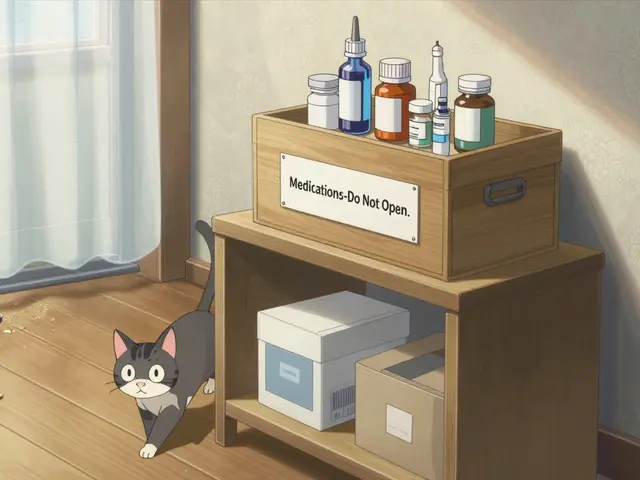Quick Takeaways
- Drug tolerance is a real, measurable reduction in a medication’s effects after repeated use.
- Three core mechanisms-pharmacokinetic, pharmacodynamic, and cellular adaptation-drive the process.
- Side‑effects often disappear faster than therapeutic benefits because different systems adapt at different speeds (differential tolerance).
- Genetics, enzyme induction, and receptor remodeling explain why patients vary widely in tolerance trajectories.
- Clinicians can use drug holidays, dose tweaks, and pharmacogenetic testing to keep side‑effects in check.
Ever noticed that the nausea from a new antidepressant fades after a couple of weeks while the sexual side‑effect sticks around? That’s not a coincidence-your body is building drug tolerance in a very specific way. Below we unpack why some side effects disappear, which mechanisms are at play, and what you can do about it.
What Is Drug Tolerance?
Drug tolerance is a pharmacological phenomenon where repeated exposure to a medication leads to a diminished physiological response. The World Health Organization defines it as a reduced reaction to a drug after its continuous or intermittent use. In plain language, the same dose that once caused drowsiness or nausea now feels almost normal.
How Does Tolerance Make Side Effects Fade?
Scientists split tolerance into three overlapping mechanisms. Each one rewires how the body sees the drug, and each can act on different side effects at different speeds.
1. Pharmacokinetic (Metabolic) Tolerance
When the liver learns to process a drug faster, the blood concentration drops sooner. This speed‑up is mostly driven by induction of Cytochrome P450 enzymes. For example, chronic barbiturate use can boost CYP3A4 activity by up to 250%, while ethanol ramps up CYP2E1 by 300% after weeks of heavy drinking. Faster clearance means the concentration that caused early side effects never reaches the same peak again.
2. Pharmacodynamic Tolerance
Here the drug still reaches the same blood level, but the targeted receptors have become less responsive. Two key changes happen:
- Receptor down‑regulation - the cell reduces the number of receptors (often 20‑50% fewer) after continuous stimulation.
- Reduced binding affinity - the drug doesn’t stick as tightly, needing higher concentrations for the same effect.
Pharmacodynamic tolerance explains why the “high” from opioids fades after a few doses while constipation lingers; the opioid receptors that mediate euphoria adapt quickly, but those in the gut do not.
3. Cellular Adaptation (Subunit Re‑assembly)
Chronic exposure can reshuffle the subunits that make up ion‑channel receptors. In alcohol users, NMDA receptors swap in more R2B subunits (40‑60% increase), while GABA‑A receptors lose δ‑subunits (30‑50% drop). These molecular swaps change the whole signaling cascade, often dampening the side effect that originally triggered the user’s discomfort.

Differential Tolerance Across Drug Classes
Not all side effects fade at the same rate. Below is a snapshot of how tolerance unfolds for four common medication groups.
| Drug class | Side effect that wanes quickly | Typical time to 50% reduction | Side effect that persists | Typical persistence level |
|---|---|---|---|---|
| Opioids | Respiratory depression / nausea | 2-3 days | Constipation | ~90% of initial intensity |
| Benzodiazepines | Sedation | 7-14 days | Anxiolytic effect | 85-90% retained |
| Antipsychotics | Extrapyramidal symptoms | 4-6 weeks | Therapeutic antipsychotic effect | 90%+ maintained |
| Beta‑blockers | Initial fatigue | ~3 months | Blood‑pressure control | Unchanged |
These numbers come from dozens of clinical studies and real‑world patient surveys. The key lesson: the nervous system, gut, and cardiovascular system each adapt on their own timetable.
Clinical Implications: Managing Fading Side Effects
When a side effect disappears, you might be tempted to raise the dose for extra benefit. That can backfire because the underlying tolerance mechanisms are already at work.
- Proactive monitoring: For opioids, prescribe a stool softener from day one because constipation rarely tolerates.
- Drug holidays: Brief pauses (7‑10 days) can reverse metabolic tolerance by 40‑60% for agents like nitroglycerin.
- Therapeutic drug monitoring (TDM): Helpful for narrow‑window drugs (e.g., lithium) where small concentration changes matter.
- Pharmacogenetic testing: Variants in CYP2D6 affect codeine conversion; 7‑10% of Caucasians are poor metabolizers, leading to reduced analgesia and altered tolerance patterns.
Understanding that tolerance is not synonymous with dependence helps clinicians avoid unnecessary dose escalations that could spur addiction.
What Drives Individual Differences?
Two big families of factors explain why one patient’s nausea fades in two weeks while another’s lasts a month.
Genetic polymorphisms
Genes coding for metabolic enzymes (CYP2D6, OPRM1) can speed up or slow down drug clearance. Studies show a 30‑40% inter‑individual variability in tolerance rates for opioids.
Receptor subtype expression
People differ in baseline levels of NMDA or GABA‑A receptor subunits. Chronic alcohol users, for instance, up‑regulate NMDA R2B subunits, making them more tolerant to excitatory side effects but still sensitive to sedative effects.
Age, liver health, and concurrent meds
Older adults often have reduced hepatic blood flow, limiting enzyme induction. Mixing an inducer like rifampin with an antidepressant can accelerate tolerance to drowsiness, masking it before the therapeutic effect stabilizes.
Emerging Research & Future Directions
Pharma companies are now building “tolerance‑resistant” formulations. Phase III trials of polymer‑encapsulated oxycodone showed a 60% drop in respiratory‑depression tolerance after eight weeks, while analgesia stayed strong.
Genetic testing is becoming routine. The NIH’s Tolerance Research Initiative (2024) funds projects that link OPRM1 variants to rapid opioid‑side‑effect tolerance, aiming for a predictive test by 2027.
Regulators are also tightening requirements. The FDA now asks new CNS drugs to list expected tolerance timelines for major side effects, a shift that should give patients clearer expectations.
Take‑Home Checklist for Patients and Providers
- Identify which side effects are likely to fade (e.g., nausea, sedation) and which tend to persist (e.g., constipation, sexual dysfunction).
- Set a monitoring schedule: weekly for the first month, then monthly.
- Consider a drug holiday if metabolic tolerance is suspected.
- Ask about pharmacogenetic testing if dose escalation feels “unusual.”
- Document any persistent side effects and discuss adjunct treatments early (e.g., laxatives, phosphodiesterase‑5 inhibitors).
Why does nausea from SSRIs disappear faster than sexual dysfunction?
Nausea is tied to serotonin spikes that the gut quickly adapts to via receptor down‑regulation. Sexual dysfunction involves long‑term changes in dopamine pathways, which adapt much slower, so the side effect persists.
Can a drug holiday reverse opioid tolerance?
Yes. A 7‑10‑day break can reduce metabolic tolerance by 40‑60% and partially reset receptor sensitivity, making the next dose feel stronger.
Should I get tested for CYP2D6 before starting codeine?
If you have a history of poor pain control or unusual side effects, a simple saliva test can identify CYP2D6 status and guide whether codeine will be effective or cause excessive tolerance.
What’s the difference between tolerance and dependence?
Tolerance means you need more drug for the same effect. Dependence means your body experiences withdrawal when the drug stops. You can have tolerance without dependence.
How long does it usually take for benzodiazepine sedation to wane?
Sedation typically drops 60‑70% within 7‑14 days of continuous use, while anxiolytic benefits remain near‑full strength.








krishna chegireddy
October 24, 2025 AT 20:06What you see in the paper is just the tip of a massive pharma agenda. They want us to believe tolerance is natural, but the real goal is to lock us into endless cycles of new pills. The truth is hidden behind glossy charts and fancy terms.
Tamara Schäfer
October 24, 2025 AT 20:31It’s fascinating how the body can adapt, almost like a quiet lesson in resilience. Seeing the science broken down helps many feel less scared about those early side effects. Keep looking at the bright side of recovery.
Jonah O
October 24, 2025 AT 20:56The story of drug tolerance is more than just chemistry, it is a social engineering project.
Big Pharma designs molecules that wear you down just enough to keep you buying more.
First the body feels nausea or dizziness, and you think you will quit.
Then the hidden metabolic pathways speed up, and the bad feeling fades.
This is not a miracle, it is a deliberate feature built into the drug’s lifecycle.
The enzymes in your liver become overactive, a process they call induction, but it is really an exploitation.
Meanwhile the receptors in your brain down‑regulate, making the original high vanish.
The result is that you need a higher dose to feel the same effect, a classic trap.
This trap is masked by the comforting language of “tolerance development” in every label.
Patients are told to wait, to accept, and to trust the prescribing physician.
Yet the prescribing physician may be another pawn, fed by incentive bonuses.
The real danger is that the body’s adaptation is fast, while the side effects that matter to quality of life linger.
Constipation from opioids, sexual dysfunction from SSRIs, and weight gain from antipsychotics stay stubborn.
The industry knows this and pushes adjunct drugs to keep the revenue stream alive.
What is called a “drug holiday” is a band‑aid, not a cure, because the underlying receptor changes remain.
Understanding this hidden agenda gives patients a chance to demand smarter, less addictive therapies.
Aaron Kuan
October 24, 2025 AT 21:21Your post reads like a rollercoaster of jargon.
Brett Witcher
October 24, 2025 AT 21:46The mechanisms outlined-pharmacokinetic, pharmacodynamic, and cellular adaptation-form a clear hierarchy that explains why some adverse effects wane quickly while others persist. It is especially useful to note the quantitative changes, such as the 20‑50% receptor down‑regulation, because they give clinicians a concrete target. The table summarizing tolerance patterns across drug classes is a nice visual aid. Overall the article balances depth with accessibility, making it a valuable reference for both prescribers and patients.
Benjamin Sequeira benavente
October 24, 2025 AT 22:11Exactly, we need to act on those numbers, not just the theory. Push for dose tweaks early, and don’t wait for side effects to become chronic. Let’s keep the pressure on pharma to design smarter meds.
Olivia Harrison
October 24, 2025 AT 22:36One practical tip for patients dealing with lingering constipation on opioids is to start a stool softener from day one, rather than waiting for the problem to appear. Likewise, for sexual dysfunction caused by SSRIs, a low‑dose bupropion add‑on can sometimes restore libido without losing antidepressant efficacy. Monitoring schedules-weekly for the first month, then monthly-help catch side effects before they solidify. Finally, discuss pharmacogenetic testing with your doctor; knowing your CYP2D6 status can prevent dose escalations that contribute to tolerance.
Abhinav B.
October 24, 2025 AT 23:01Thanks for the solid advice, especially the early stool softener suggestion-many forget that. In my experience, patients also appreciate a simple chart of expected side‑effect timelines, it reduces anxiety. Keep sharing these culturally aware pointers.
Lisa Woodcock
October 24, 2025 AT 23:26From a cultural standpoint, some communities view persistent side effects as a sign of weakness, which can delay seeking help. Educating patients in a culturally sensitive way about the normal course of tolerance can improve adherence. Sharing stories from within the community often makes the information stick.
Clinton Papenfus
October 24, 2025 AT 23:51Your observations underscore the need for culturally tailored education programs. Implementing such programs can increase early reporting of adverse effects and optimise therapeutic outcomes.